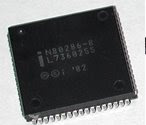During this period Andy Grove radically redirected the company, closing much of its DRAM business and directing income to the microprocessor commerce. Of perhaps greater importance was his choice to "single-source" the 386 microprocessor. Prior to this, microprocessor developed was in its infancy, and developed problems often reduced or stopped production, interrupt supplies to customers. To mitigate this risk, these customers typically insisted that multiple manufacturer produce chips they could use to ensure a consistent supply. The 8080 and 8086-series microprocessors were shaped by several companies, notably Zilog and AMD. Grove made the choice not to license the 386 design to other manufacturers, instead produce it in three geographically distinct factories in Santa Clara, CA; Hillsboro, OR; and the Phoenix, Arizona suburb of Chandler; and convincing patrons that this would ensure consistent release. As the success of Compaq's Deskpro 386 recognized the 386 as the dominant CPU choice, Intel achieve a position of near-exclusive supremacy as its supplier. Profits from this funded rapid growth of both higher-performance chip design and higher-performance developed capabilities, propelling Intel to a position of unquestioned management by the early 1990s.
Monday, October 20, 2008
Monday, October 13, 2008
Intel, x86 processors, and the IBM PC
Despite the ultimate significance of the microprocessor, the 4004 and its successors the 8008 and the 8080 were never major revenue contributor at Intel. As the next processor, the 8086 was finished in 1978; Intel embarked on a major advertising and sales campaign for that chip nicknamed "Operation Crush", and planned to win as many customers for the processor as probable. One design win was the newly-created IBM PC division, though the significance of this was not fully realized at the time.
IBM introduced its personal processor in 1981, and it was rapidly successful. In 1982, Intel shaped the 80286 microprocessor, which, two years later, was old in the IBM PC/AT. Compaq, the first IBM PC "clone" manufacturer, in 1985 produced a desktop scheme based on the faster 80286 processor and in 1986 quickly follow with the first 80386-based system, beating IBM and establish a competitive market for PC-compatible systems and setting up Intel as a key component dealer.
In 1975 the company had started a project to expand a highly-advanced 32-bit microprocessor, finally free in 1981 as the Intel iAPX 432. The project was too ambitious and the processor was not at all able to meet its recital objectives, and it failed in the marketplace. Intel extensive the x86 architecture to 32 bits instead.
Sunday, October 05, 2008
Intel's SRAMS and the microprocessor
The company's first goods were shift register memory and random-access memory integrated circuits, and Intel grew to be a leader in the fiercely competitive DRAM, SRAM, and ROM markets all through the 1970s. Concurrently, Intel engineers Marcian Hoff, Federico Faggin, Stanley Mazor and Masatoshi Shima imaginary the first microprocessor. Originally urbanized for the Japanese company Busicom to restore a number of ASICs in a calculator already shaped by Busicom, the Intel 4004 was initiate to the mass market on November 15, 1971, although the microprocessor did not become the core of Intel's business until the mid-1980s.




